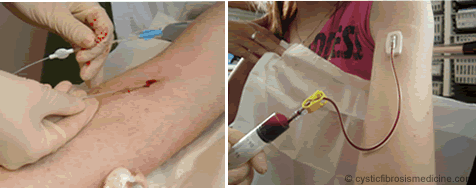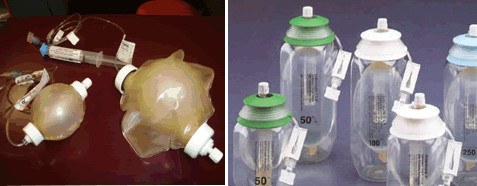Home intravenous therapy
Introduction
One of the major responsibilities and areas of particular expertise of the Cystic Fibrosis (CF) Nurse Specialists (CFNS) is organising intravenous antibiotic therapy in the patient’s own home. Many studies have demonstrated that adequately supervised home intravenous antibiotic treatment (HIVT) is a practical, effective and acceptable alternative to hospital treatment for many patients (Gilbert et al, 1988; Peckham & Knox, 1993; Pond et al, 1994; Riethmuller et al, 2002).
We carry out, on average, 200 courses of HIVT at the paediatric CF Unit at St James Hospital each year. Any patient wishing to participate in HIVT is made known to the CFNS to allow open discussion of the criteria that must be met to ensure the safety of intravenous drug administration at home (Cottrell et al, 1998). Parents of our children are invited to an intravenous study evening which is held in the CF Unit. Following this evening, the CFNS visits the family to assess the home environment and to discuss issues such as preparation areas and storage. A fast track teaching has been set up for parents and children in the outpatients department. This can eliminate the need for even a few days hospital admission to consolidate teaching at the beginning of the first course of HIVT (McLaughlin et al, 1999).
At the beginning of the HIVT course the patient and parent/carer attend the CF Unit where the patient will have their height, weight and respiratory function tests carried out, and see a physiotherapist. The patient is examined by the CF doctor and relevant blood tests taken. Venous access is obtained using the patient’s totally indwelling venous access device (TIVAD) if available, or through a longline. The parent and/or patient are taught how to administer the intravenous antibiotics safely. We supervise the administration of the first three doses of the first course of treatment. For subsequent courses only the first dose is required to be given under supervision, unless the antibiotic is being prescribed for the first time in which case two doses are supervised to reduce any risk of an allergic reaction occurring in the home. The patient is required to stay within the CF Unit during administration of the antibiotic and for half an hour afterwards. During this time, instructions are given on the various charts which are completed during home treatment. All patients are issued with an anaphylaxis kit and concise instructions are given about procedures to follow in the event of an adverse reaction. This may be supported by attendance at a first aid evening where parents can learn basic resuscitation techniques.
After seven days the CFNS makes a home visit. Respiratory function tests are repeated, and sputum or cough swab specimens collected. Blood aminoglycoside (usually tobramycin) antibiotic levels are also repeated at this visit. An assessment of progress is made and any relevant action is taken. At the end of the two week course of HIVT the patient attends the CF Unit. Respiratory function tests are done, the patient is weighed and height measured. A sputum sample or cough swab is obtained. The patient is reviewed by the doctor, physiotherapist and dietitian as required, and a decision is taken about whether maximal improvement has occurred or whether further treatment is required.
The role of the CFNS is central to a satisfactory HIVT service. If this type of treatment is to be undertaken it is essential that there is adequate support from the hospital. Home intravenous antibiotics therapy services should be frequently audited. We strive to expand, develop and improve the service to provide easy, flexible, safe and effective home treatment.
Home intravenous therapy on the adult unit
Over 500 courses of intravenous therapy are carried out annually at the Adult CF Unit where a team of four full-time experienced CFNS and a full time support worker cover all aspects of the home therapy programme. It is important to be aware that strict criteria need to be fulfilled by the patient before a course of intravenous antibiotic treatment can be given in the home environment. If at any time it is felt that the patient is not improving or adherence is poor, the treatment will be discontinued at home and the patient admitted for in-patient treatment. Each course of therapy undertaken by the patient is carefully monitored by senior members of the medical team. Blood results, including antibiotic levels, and sputum results are reviewed daily and any adjustments to treatment are communicated to the patient.
A system is in place to provide teaching for patients who have not previously carried out treatment at home. Some patients prefer to have several days as an in-patient taking on board all of the information required. A fast track system can be made available over a two day period where the patient attends as a day case.
The patient’s latest sputum and list of antibiotic allergies is taken into account when prescribing antibiotic combinations for the start of treatment. For patients without an indwelling port, venous access can often be the cause of great stress and anxiety. It is of vital importance that this procedure runs smoothly to minimise any long term problems for future therapy. A senior member of the team or a CF nurse specialist with experience in long line insertion should be available to ensure that problems are kept to a minimum.

Figure 1. Examples of venous access: long line (left) and P.A.S Port (right).
The present protocol dictates that the first dose of each antibiotic prescribed is administered in hospital, the patient attending as a day case. If the patient has never been treated with a particular antibiotic before, the first two doses are administered in hospital. All patients are taught how to treat any drug reaction and provided with an anaphylaxis kit.
A multi-disciplinary ward round to discuss patients on home intravenous therapy takes place weekly. All aspects of their current treatment are discussed in detail to ensure the patient receives the best treatment at all times. Abnormal blood results are highlighted and acted upon. The CFNS discuss any new problems on a daily basis with a senior member of the medical team.
It is important that any patient who has experienced problems, or about whom the CFNS are concerned, is reviewed by a senior doctor at the end of treatment. Their follow up appointment can thus be tailored to their individual needs.

Figure 2. Examples of Eclipse (left) and Intermate devices (right)
The majority of home intravenous antibiotics are administered via the Intermate, Eclipse or alternative devices. These consists of a reservoir balloon containing the antibiotic solution which is maintained at a constant, positive pressure. An internal flow metered device produces a known preset, flow rate for the delivery of the antibiotic. They are fitted with luer lock connectors and are simply connected to the patient’s intravenous line. The majority of drugs used can be supplied via the Intermate with the exception of meropenem and Teicoplanin. This is because both drugs are not suitable and require reconstituting prior to being used.The Intermate is designed to avoid the problems of reconstitution of the drugs and the need for gravity flow, electronic pumps or syringes. Once connected they can be slipped into garment pockets, allowing the patient to continue with their activity. An added advantage is that once in place the infusion drug is discreet and unobtrusive.
The volume of fluid within the Intermate or Eclipse can be varied, as can the flow rate by speeding up or slowing down the infusion rate of the drug in line with manufactures recommendations and patient preference. This procedure is controlled by the pharmacy producing the drug.
Key points
• Many studies have demonstrated that adequately supervised home intravenous antibiotic treatment (HIVT) is a practical, effective and acceptable alternative to hospital treatment for many patients
Recommendations
• Any patient wishing to participate in HIVT is made known to the CFNS to allow open discussion of the criteria that must be met to ensure the safety of intravenous drug administration at home
• If at any time it is felt that the patient is not improving or adherence is poor, the treatment should be discontinued at home and the patient admitted for in-patient treatment
• Patients are issued with an anaphylaxis kit and concise instructions given about procedures to follow in the event of an adverse reaction
• Home intravenous antibiotics should be administered using Intermate, Eclipse or alternative devices where possible as this avoid the problems of reconstitution of the drugs and the need for gravity flow, electronic pumps or syringes
References
Cottrell J, Burrows E. Community-based care in cystic fibrosis: role of the cystic fibrosis nurse specialist and implications for patients and families. Disabil Rehabil 1998; 20: 254-261. [PubMed]
Gilbert J, Robinson T, Littlewood JM. Home intravenous antibiotic treatment in cystic fibrosis. Arch Dis Child 1988; 63: 512-517. [PubMed]
McLaughlin S, Brownlee KG, Conway SP. Homecare – optimising, enhancing and simplifying intravenous treatment. The Nether J Med 1999; 54 (Suppl): S77.
Peckham D, Knox A. Intravenous antibiotic therapy in cystic fibrosis:in hospital or at home. Respir Med 1993; 87: 329-330. [PubMed]
Pond MN, Newport M, Joanes D, et al. Home versus hospital intravenous antibiotic therapy in the treatment of young adults with cystic fibrosis. Eur Respir J 1994; 7: 1640-1644. [PubMed]
Riethmueller J, Busch A, Damm V, et al. Home and hospital antibiotic treatment prove similarly effective in cystic fibrosis. Infection 2002; 30: 387-391. [PubMed]
